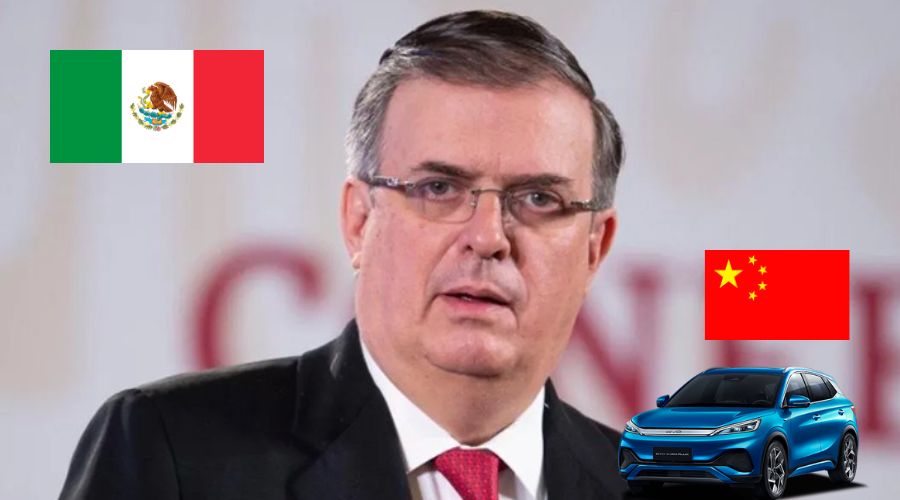As anticipated last week, Mexico has outlined a new tariff policy on imports from countries without a trade agreement. Chinese vehicles are among the most affected, as the federal government proposes tariffs of up to 50%.
Economy Secretary Marcelo Ebrard Casaubón announced on Tuesday that the 2026 Budget Proposal sent to Congress includes this tariff, aimed at “curbing a growing trade deficit”, particularly focused on light vehicles, plastics, and electronic components.
Speaking at the 2025 SME Expo in Monterrey, Ebrard highlighted that the tariff policy will align with the Plan México and the upcoming USMCA (T-MEC) review scheduled for July 2026.
“Vehicles coming from Asia, particularly China, already face a tariff — 20%. So, what are we going to do?”
“We’re going to raise it, to the limit allowed by the World Trade Organization — up to 50%. Because the prices at which they are entering Mexico are below what we call reference prices,” he told the press.
Former U.S. President Donald Trump has claimed that China is using its proximity to Mexico to “sneak” in cheap vehicles, which he says compete “unfairly” with North American production.
Although President Claudia Sheinbaum has clarified that the tariffs will not target China exclusively, the Asian giant remains the main focus, with the “invasion” of Chinese electric vehicles becoming a national concern.
Chinese cars: a game changer for Mexican e-mobility
The Mexican automotive sector shared its stance during the Monthly Conference hosted by the National Auto Parts Industry (INA), the Mexican Association of Automotive Distributors (AMDA), and the Mexican Automotive Industry Association (AMIA).
“Of course, the issue of China will be a strategic one in the upcoming USMCA review; it has been prioritised in the design of future strategies,” said Gabriel Padilla, General Director of INA.
“However, I should point out that China’s current strong presence is more noticeable in the aftermarket sector.”
“In terms of spare parts and replacements, the Mexican market does distinguish between price and quality — comparing Chinese components with brands already established in Mexico,” he added.
“We believe that, in the context of the USMCA review, the goal is for Mexico to continue serving as a manufacturing platform. We are currently carrying out internal industry consultations to determine which parts and components could be subject to tariffs to protect our domestic production,” Padilla explained.
“Yes, we’re seeing strong pressure from the United States to prevent finished Chinese vehicles from using Mexico as a platform for export,” he acknowledged.
“The automotive sector today also faces major challenges regarding origin and traceability of parts and components — especially from China. But we also need to understand, ahead of the review, which parts and components North America is highly dependent on,” he warned.
Padilla also confirmed that industry representatives are working closely with the Ministry of Economy, and that “by October, we’ll have a much clearer position on the matter.”
Tensions with China in the automotive sector
Earlier this year, BYD — the world’s leading Chinese electric vehicle manufacturer — confirmed that it had scrapped its plans to set up a plant in Mexico, opting instead to open a factory in Brazil, where conditions are reportedly more “favourable”.
Although BYD’s vehicles are extremely popular among Mexican consumers and the brand boasts a robust dealership network in the country, its expansion in Mexico is, for now, limited to sales and distribution.
Speaking to Mobility Portal Latinoamérica, Cristina Vázquez from AMDA commented: “There’s no doubt that any measure such as the imposition of tariffs has a negative impact on the final consumer of Chinese cars.”
However, she clarified that as far as the association’s official position is concerned, “we still need to understand in more detail what the actual proposal entails.”
Padilla agreed with Vázquez, noting that “while tariffs aim to protect domestic production from unfair competition — in this case from Chinese vehicles — there’s still a lack of clarity about the actual impact on the automotive sector.”
“Within the industry, we must differentiate between tariffs on fully assembled Chinese vehicles and those that may be applied to parts and components,” Padilla specified.
“There are products that aren’t finished goods and are used to complement manufacturing processes carried out in Mexico, currently complying with rules of origin. When it comes to auto parts, a blanket tariff policy is not advisable for all Chinese components.”
“Our position is that the best scenario to discuss such measures would be within the context of the USMCA review alongside our counterparts in the United States and Canada.”
“So, we’re heading into the end of the year with significant uncertainty. What we need, particularly in terms of tariff policy, is to reach the best possible agreement to preserve regional competitiveness — especially against Asia and Europe,” he concluded.
READ MORE
-
Flexecharge CEO: “The Virtual Power Plant will reach new European countries in 2025 and 2026”
Following the success of launching the world’s first VPP based on high-power public DC chargers, Flexecharge will expand to new countries, partnering with major CPOs.
-
3M launches brand initiative to transform the charging experience across EMEA
The new initiative aims to turn charging stations into visually appealing, functional, and user-friendly spaces through graphic solutions that enhance experience and safety. What’s next for 3M?
-
Spanish CPO partners to expand its charging network in France with 2,500 points
This marks a crucial step in accelerating its presence in France, which still lags behind in public charging infrastructure, despite over 175,000 points already in place.









